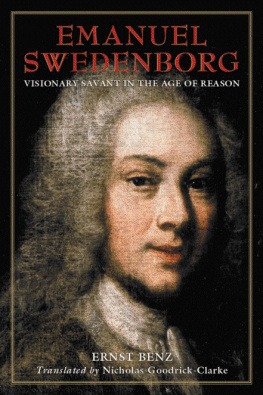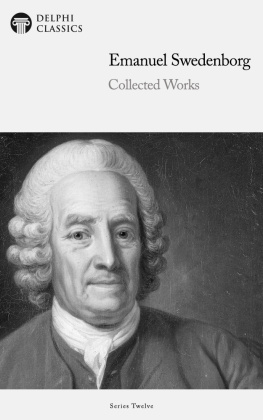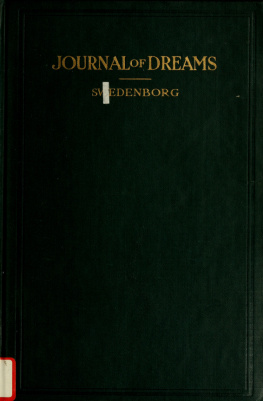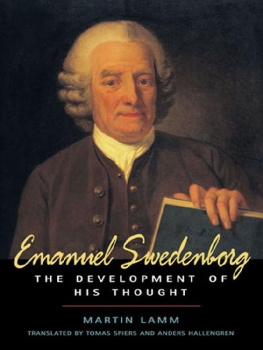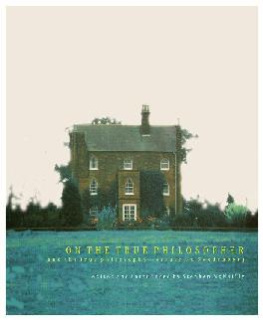Emanuel Swedenborg
VISIONARY SAVANT IN THE AGE OF REASON

BY
ERNST BENZ
Introduced and Translated by Nicholas Goodrick-Clarke

Swedenborg Foundation
West Chester, Pennsylvania
Translation and introduction 2002 by Nicholas Goodrick-Clarke
This work was originally published as Emanuel Swedenborg: Naturforscher und Seher. Edited by Friedemann Horn. Second edition. Zurich: Swedenborg Verlag, 1969. First publication 1948.
All rights reserved. No part of the publication may be reproduced or transmitted in any form or by any means, electronic or mechanical, including photocopying, recording, or any information storage or retrieval system, without prior permission from the publisher.
Swedenborg Studies is a scholarly series published by the Swedenborg Foundation. The primary purpose of the series is to make materials available for understanding the life and thought of Emanuel Swedenborg (16881772) and the impact his thought has had on others. The Foundation undertakes to publish original studies and English translations of such studies and to republish primary sources that are otherwise difficult to access. Proposals should be sent to: Senior Editor, Swedenborg Studies, Swedenborg Foundation, 320 North Church Street, West Chester, Pennsylvania 19380.
Library of Congress Cataloging-in-Publication Data
Benz, Ernst, 19071978
[Emanuel Swedenborg. English]
Emanuel Swedenborg : visionary savant in the age of reason / by Ernst Benz ; translated by Nicholas Goodrick-Clarke.
p. cm.(Swedenborg studies ; no. 14)
Includes bibliographical references and index.
ISBN 0-87785-195-6
ISBN 978-0-877856-23-8(electronic)
1. Swedenborg, Emanuel, 16881772. I. Title. II. Series.
BX8748 .B3913 2002
289.4092dc21
2002001156
Edited by Mary Lou Bertucci
Cover design by Karen Connor
Interior design by Sans Serif, Inc., Saline, MI
Set in Galliard by Sans Serif, Inc., Saline, Michigan
Printed in the United States of America.
www.swedenborg.com
Contents
Introduction
By any estimate, Emanuel Swedenborg (16881772) claims an exceptional place in history, both as famous scientist and as visionary. Born at the end of a troubled century, Swedenborg spans the crucial construction of the modern worldview based on reason, science, and material progress. Before he was yet twenty-five, the precocious Swedish genius had already worked alongside Sir Isaac Newton, Edmund Halley, and other leading scientists in England, France, and Holland. From 1680 to 1715, when Swedenborg first came to London and Paris, the new sciences of astronomy, physics, chemistry, and biology were forged by such figures as Christian Huygens, Robert Boyle, Robert Hooke, and Hermann Boerhaave. Meanwhile, philosophers such as Ren Descartes and Benedictus de Spinoza supplied a philosophy that was geometric, mechanistic, and optimistic concerning the rational and beneficial order of the universe. Between 1700 and 1740, European science rapidly developed a rational understanding of nature to harness its powers for human purposes. This rapid accumulation of scientific knowledge and its application in navigation, engineering, and industry unleashed an unprecedented wave of economic growth in Europe and laid the basis of European colonial expansion.
Swedenborg inhabited this mental world, working on a fast-revolving stage of new discoveries, inventions, machines, and large engineering projects. He traveled widely through Europe and published pioneering works in such diverse fields as astronomy, physics, engineering, chemistry, geology, anatomy, physiology, and psychology. At the same time, he played a prominent role in Swedish public institutions concerned with mining, finance, and politics. These worldly, rational interests totally absorbed Swedenborg. Until his fiftieth birthday, he appeared uninterested in religion and hardly participated in organized church worship. Then, at the peak of his powers, a renowned figure of European science and member of the Swedish Academy of Sciences, Swedenborgs life changed forever in the spring of 1744.
While traveling through Holland during Easter week, Swedenborg underwent an emotional crisis culminating in a nocturnal vision of Christ. He fell from his bed, found himself resting on Jesus chest, and felt he had been divinely commissioned to a special task. In the following months, Swedenborg sought direction and focus for his new religious feeling. He kept a revealing dream diary and wrote Worship and Love of God , an extraordinary blend of mythology and science. Then, in the spring of 1745, while a resident in London, he had his first vision of the spiritual world and its inhabitants. The Lord God appeared to Swedenborg and told him his mission was to explain to men the spiritual meaning of Scripture.
Henceforth, Swedenborg possessed the gift of vision into the spirit world and received constant inspiration for his new vocation. In 1748, he began working on Arcana Coelestia , a major eight-volume visionary work, which heralded a stream of books devoted to theology and biblical exegesis, including Earths in the Universe , The Last Judgment , New Jerusalem and Its Heavenly Doctrine , and his most famous book Heaven and Hell , all published in 1758. During the 1760s, he continued to publish substantial works, all based on an interpretation of Scripture, which the angels explained to him through spirit vision in palaces and parks, in lecture halls, colleges, and conferences among wonderful or ominous landscapes. Swedenborgs visionary faculty was unique. Rather than raptures, mystical union, and ascent experiences common to the famous English, German, and Spanish mystics from the Middle Ages to the seventeenth century, Swedenborgs visions were always related to the meaning of Scripture, which lends his writing an astonishing matter-of-factness. We read a prosaic yet compelling record of encounters with spirits who offer detailed information concerning God, heaven and earth, humankinds purpose, the Last Judgment, and the life to come. Never before had a Christian visionary written with the intellectual training and achievements of a leading European scientist.
If Swedenborg had already won European renown as a scientist in several fields, his new visionary career now made him notorious. If Swedenborgs birth dovetailed with the rise of modern European thought, his new spiritual vocation seemed quite at odds with its climax in the Enlightenment. By mid-century, the worship of nature and reason, so prominent in the thought of Voltaire, Rousseau, and Kant signaled the advent of a secular post-religious era. Swedenborg necessarily attracted controversy, and sides were quickly taken. In 1760, Friedrich Christoph Oetinger (17021782), the prominent German Pietist and church prelate, defended Swedenborgs work and invited him to Germany. Meanwhile, Kant wrote a scathing and, by his later admission, unjust work, Dreams of a Sprit-Seer (1766), which damaged Swedenborgs reputation among Enlightenment thinkers. While Swedenborgs visions were the talk of England, France, and Germany, ecclesiastical controversy broke out in his native Sweden, and steps were taken to declare his work heretical. Eventually, this storm blew over: Swedenborg was rehabilitated and died at the age of 84 in London in 1772. By the end of the century, his many followers in England had founded the New Church to promote his doctrines, which spread through missions to the United States and other countries in the nineteenth century. In 1908, Swedenborgs body was re-interred at Uppsala Cathedral. He is revered as a famous son of his country, and his earthly remains lie besides those of kings and other leading figures of Sweden.
Next page
